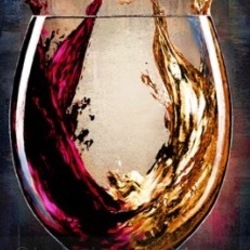Fourth Estate
Orin Swift Cellars
Machete Petite Sirah Blend
The label is, as usual, original. It's my fourth wine from Orin Swift Cellars (after "Abstract", "Papillon" and "Palermo"). And it's fantastic.
it is a blend of petite syrah, syrah and grenache. Ink color. The nose is full of fruity aromas: a plum, a blackberry and a blackcurrant and sweet liqueur aromas. Also the palate. But there you can also find a leather and a cocoa. Pleasant acidic finale reduces sweetness and closes this wine. — 5 years ago
Domaine Drouhin
Dundee Hills Pinot Noir
Established in 1987, DD Oregon is owned by famed Burgundy producer, Maison Joseph Drouhin. Hand-crafted by fourth generation winemaker, Veronique Drouhin-Boss. Ruby with fruit and sweet floral scents, very French in style. On the palate cherry and blueberry with pepper and earthy notes. Young but integrated tannins, well defined, elegant with underlying richness, long finish.
— 6 years ago
Joseph Phelps Vineyards
Napa Valley Cabernet Sauvignon 2004
Happy Fourth of July!!! 🇺🇸
No better bottle to open than a magnum for a celebration.
A ton better than the last time and another magnum. Deep garnet red. Layered nose with dark fruits, plums, spices, purple floral notes and toasted wood. Medium tannins (6.5/10) and medium to medium plus body. Palate has notes with black cherries, dark cocoa, and gravel. Long finish. Drink till 2020. — 8 years ago
Château Lafon-Rochet
Saint-Estèphe Cabernet Sauvignon Blend 2008
Fourth-growth Bordeaux 👌🏻 — 8 years ago
Dominique Roger (Domaine du Carrou)
Sancerre Rouge Pinot Noir 2014
Fourth day open; absolutely rocking. Rhubarb, hard candy, balsa wood, flint. Suave, fine, Burgundian. #sancerre #pinotnoirs — 9 years ago
Château Villemaurine
St. Émilion Grand Cru Classé Red Bordeaux Blend 2018
2018 vintage…again. Nose initially had elements of baby diapers but that (fortunately) blew off quickly. Stabilized to the plum/nut/saline aromas. Medium body. A little Syrah texture here and there and beyond respectable tannins. Coffee grounds, blue fruit, tobacco and baking chocolate pay their respects on the almost über-astringent finish. Really youthful but in balance now. Nicely made. Tasting for the fourth time in six months and consistent throughout. Underrated. — 4 years ago
Château Smith Haut Lafitte
Le Petit Haut Lafitte Red Bordeaux Blend 2016
Fourth wine of the week. Very good second wine - 60 Cabernet / 40 Merlot from younger vines. Brambly blackberry, cranberry, olives with tobacco notes and a smidge of graphite. Tannins are ripe and smooth. Lacks the concentration and layered complexity of the grand vin, but still very good. 2016 vintage on April 19, 2020 — 5 years ago
Pierre Péters
Cuvée de Réserve Grand Cru Brut Blanc de Blancs Champagne
Had this over a year ago, this is a new batch, a Fav! Rodolphe Péters took over the reins of this venerable estate in the southern Côte des Blancs in 2008, becoming the fourth generation to lead since the estate was founded in 1919, under the name Camille Péters. 100% Chardonnay, Crisp, fine mousse with steady flow of bubbles. Citrus, and biscuit aromas. Fresh fruit flavors of peach, apples and lemons, smooth and dry. Long mineral finish ending with elegance. Nice! — 6 years ago
Château Duhart Milon
Pauillac Cabernet Sauvignon - Merlot Blend 2006
The 06 vintage was more highly praised by the Bordelais than it delivered. That’s not to say, some producers didn’t deliver.
This 06 is not at its peak...still needs a few years. Will it be a wine that blows you away? Not likely but, it will deliver nice fruit, earth & balance. Especially, with a Ribeye.
The nose shows; ripe; blackberries, dark cherries, black raspberries, baked strawberries, dry cranberries & some black plum. Saddle-wood, limestone minerals, dry stones, cinnamon, soft spice, light vanilla, black rich earth, touch of black licorice and red & dark fresh florals.
The body is round and a little lean but puts on weight with food and decanting. The structure, length & tension are falling into place. The fruits are ripe and expressive. Blackberries, dark cherries, black raspberries, baked strawberries, haunting blue fruits, dry cranberries & some black plum. Saddle-wood, touch herbaceous, mint, limestone minerals, dry clay, dry stones, cinnamon, soft spice, cola, light vanilla, black rich earth, touch of black licorice and red & dark fresh florals. The acidity is round and beautiful. The finish is on the leaner side but, well balanced and lasts a full minute. 9.1 without the Ribeye, 9.2 with it.
Photos of, Duhart Milon, Cabernet ready to to be pressed, wine making facilities and their barrel room.
Producer history and notes...the Rothschild family is divided into two sects for lack of a better word. There are the ones that own Mouton Rothschild and Cleric Milon etc. and the other owns Lafite and Duhart. The two sides of the families don’t necessarily get along. However, they are two of the oldest/wealthiest families in recorded history.
Duhart Milon was originally known only as Chateau Milon. At one time the estate was the second wine of Chateau Lafite.
The story about how this came to be is interesting. The owner of Lafite at that time was the Marquis Nicolas-Alexandre de Segur. King Louis XV called him “The Wine Prince” because of his extensive vineyard holdings in Bordeaux. The Milon vineyards were well regarded but, not as good as Lafite, which is how the wine came to be thought of as the second wine for Lafite.
In 1815, the property was considered by some people as a fourth growth Bordeaux wine in the making. In those days, the wine was sold under the name of Chateau Mandavy-Milon. Between 1830 and 1840, the Casteja family inherited the estate.
The label of Duhart Milon, according to family tradition came about from an old legend written about one of their ancestors, Sir Duhart. Sir Duhart, was rumored to have been a pirate for Louis XV. He retired in Pauillac. The “Pirate’s House” on the Pauillac port existed up to the 1950’s. That original building inspired the label for the Duhart-Milon wines.
The Casteja family remained in possession of Duhart Milon until the first part of the 20th century. At the time, Chateau Duhart Milon was one of larger Pauillac estates with around 50 hectares of vines.
In 1937, the result of successive inheritances led to the sale of Duhart Milon. The Left Bank property went through five different owners in just 25 years. As well, the vineyards were split up and with the frost of 1956, the quality of Duhart Milon continued declining until the Rothschild family purchased the property in 1962.
At that time of the sale, Chateau Duhart Milon included 110 hectares of land, of which only 17 hectares were planted with vines. The entire vineyard was in desperate need of replanting. Major renovations were urgently needed in the vineyards, which demanded work on the drainage and replanting.
The size of their vineyards were also increased with the purchase of other parcels adding to the size of their Medoc holdings. New cellars needed to be built as well.
Chateau Duhart Milon remains one of the few 1855 Classified Growth estates without an actual Chateau. At Duhart, all you will find are the cellars, vatting rooms and barrel storages.
During the period of 1970 to 2000, the vineyards nearly doubled in size! Additionally, they constructed new cellars, renovated and modernized their wine making facilities as well in 2003. By 2008, the wine of Duhart Milon increased in quality, stature and price.
Much of the price increase had to do with the association with Chateau Lafite Rothschild, which had by that time, become the most in-demand, collectible wine in China. By the time the 2015 vintage was offered, prices had dropped to a more affordable price level due to changes in Chinese laws regarding client gifts/bribes.
The 152 hectare vineyard of Chateau Duhart Milon includes; 76 hectares of vines planted to 67% Cabernet Sauvignon and 33% Merlot. This makes Chateau Duhart Milon one of the few 1855 Classified Growths with only two grape varieties planted in their vineyards.
The average age of the vines are 30 years old. The vineyard is planted to a vine density of 7,500 vines per hectare.
Duhart Milon vineyards are located in northern Pauillac, on the western side of Chateau Lafite Rothschild, on the Milon hillside, which is not far from the Carruades plateau...now Lafite’s second wine. This places the vineyard quite close to Chateau Mouton Rothschild and Chateau Clerc Milon. However, because of micro climates, this is a slightly cooler terroir, due to its northern exposure.
The naturally cooler soils provides more freshness to the wine, and allows for later picking. The terroir of Chateau Duhart Milon is a combination of gravel, sand and limestone soils. The Duhart Milon vineyards are unique in Pauillac, as the vines are for the most part, located in 1 single, large parcel.
The vinification of Chateau Duhart Milon takes place in temperature controlled stainless vats. Malolactic fermentation takes place in vat. Chateau Duhart Milon is then aged in an average of 50% new French oak barrels for 14 to 16 months, depending on the vintage.
There is a second wine, Moulin de Duhart, that was created in 1986. There is also a third wine produced by the estate, Baron de Milon. — 7 years ago


Black Stallion Estate Winery
Napa Valley Cabernet Sauvignon 2015
At the family Fourth of July party. — 4 years ago
Château Mouton Rothschild
Pauillac Red Bordeaux Blend 1945
This bottle of 1945 Mouton-Rothschild is my fourth encounter and actually showed better than one poured three months earlier that came directly from the château. Ethereal as always on the nose, that distinctive menthol scent is present and correct, and this bottle is perhaps more elegant and almost Burgundian in style. The palate has heavenly balance, quite opulent and velvety, with morello cherry, raspberry preserve, orange pith and a delicate touch of cedar on the never-ending finish. Monumental. Tasted at Koala's 1945 dinner. (Neal Martin, Vinous, May 2020)
— 5 years ago
Marcel Lapierre
Morgon Gamay 2017
Fourth time tasting Lapierre in 2017. I've got a bit of a cold so I'm not enjoying this one as the previous ones. The nose is still a cherry bomb and bears a violet stamp. The palate is still very well balanced with a strong acid backbone, lots of ripe cherry all over the place, some grip, some width. The palate is a cherry song that plays for a very long while. 24 hours later it's still singing. Great! — 6 years ago
Fourth Leaf
Rob and Angelina Mondavi's Napa Valley Cabernet Sauvignon
Outstanding. Winner of the weekend. — 8 years ago
Francois Gaunoux
Puligny-Montrachet Chardonnay
Stone harbor Fourth of July! Salmon dinner — 8 years ago
Witchery Wine
Oakville Cabernet Sauvignon 2013
Fourth of the blind tasting for Father's Day weekend.
Deep and dark purplish ruby red. Dark fruits with a touch of acetone or whiskey on the nose. Some cigars and dark cocoa as well. Heavy tannins (7.5/10) and medium bodied. A touch lighter than expected. Extracted dark fruits and bitter dark cocoa on the palate. A little unbalanced with a medium plus finish. This is still a baby and needs time to settle. Drink till 2029. — 8 years ago




















Taavi Davies
Trepidation given the age … should have been decanted but I wanted to see it develop in the glass. Golden-orange colour worried me. First was not good - heavy oxidation, caramels, nutmeg, wood (although nice and buttery). Second glass vanilla, lemon peel, burnt peaches, then it balanced out with fresh apricot and lemon zest. Crazy long apricot jam finish. At this point it became an exceptional wine. Third glass had a lovely nose, rounded and buttery on the palate, notes of orange and cinnamon (?). Fourth glass was perfect, green plums, lovely and crisp with good minerality and balance — at La Spiaggia, Constance Belle Mare, Mauritius — 3 years ago